
|
KENT GEOLOGISTS' GROUPIllustrated Microfossils |

|
Comments on the Microfossil Illustrations
A selection of microfossils is
illustrated (use link below) to give some idea of the
diversity that may be expected in sediment
samples.
Although excluded from the definition used, some
pollen grains and dinoflagellate cysts can occur in
the finer microfossil residues so two examples have
been included in the illustrations to aid their
recognition.
Molluscs, most echinoderms and fishes are usually considered to be macrofossil groups even though their remains are often abundant in microfossil samples. There are, however, many small species of mollusc that qualify, small juveniles can be abundant and cephalopod arm hooklets and very rare statoliths (ear stones thought to be partially responsible for balance) are clearly microfossils. Whilst most echinoderms are macrofossils, many break up into a myriad of isolated plates and spines which can dominate microfossil residues. The minute sclerites of the soft-bodied sea cucumbers are exclusively microfossil. Fossil fish are usually studied using articulated skeletons or isolated large teeth or bones, but even these mostly break up after death releasing tiny teeth, denticles and fish ear stones (otoliths) for the palaeontologist to find.
Worms are almost all soft-bodied and rarely leave recognisable fossils. Some tube forming species, however, produce tiny opercula whilst others have chitinous jaws (scolecodonts). Sponges either have a coherent skeleton or break up, releasing minute spicules. Apart from pollen, most higher plant remains are treated as macrofossils though a great many seeds and fruits can be quite tiny. The remaining groups featured in the illustrations are truly microfossil and always need to be studied using a microscope.
| Microfossil Illustrations | Return to Microfossils |